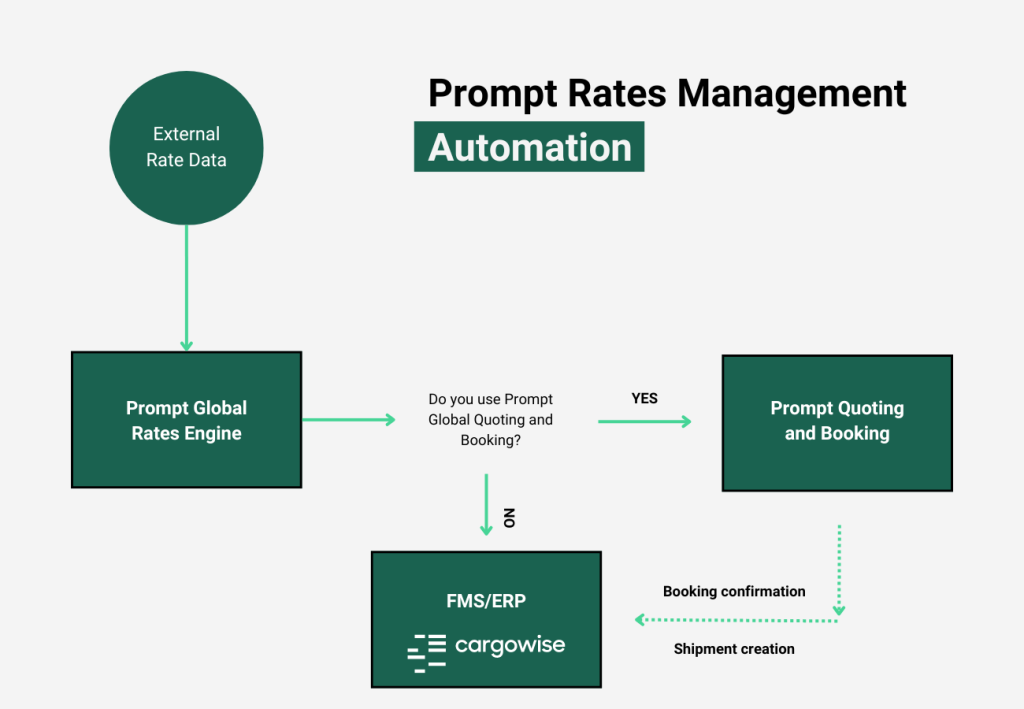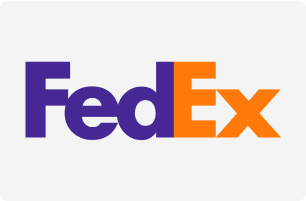Placing a booking with a forwarder shouldn’t take days. However the accumulation of inefficiencies and mistakes between the quote request and booking confirmation can really drag out the process, leading to lost business and revenue.
This all-too-common reality plagues supply chain professionals the world over, and in an industry where there is a strong correlation between time and money, accepted best practices are no longer acceptable.
This article will highlight the pain caused by inefficient booking processes, caused by a number of factors, and how these challenges can be tackled head-on with immediate positive effect through a holistic approach including software, processes, and people.
We are Prompt Global, and our mission is to simplify trade execution for freight forwarders and their customers by tackling the biggest challenges with real software and data led solutions. And this is how we solve your digital booking dilemma.
Shifting from manual to digital bookings
Change management is always a painful process. In freight forwarding and supply chains in general, any change will always impact multiple stakeholders, including those not under your direct influence as a forwarder. This makes any shift away from traditional manual processes to forwarding digitization an art form.
Placing a booking with a freight forwarding company has been an inherently manual process for the longest time. Our industry is heavily relationship based, with a reliance on tools such as excel, emails, and the telephone, to organize and follow-through on trade execution. This process, although rewarding from a people perspective, is one of the leading causes of problems for freight forwarders.

Improve business and customer relationships
Customers have long enjoyed that feeling of a tailored service with freight forwarding. Send an email or pick up the phone and call your main contact, discuss your request, then wait for the forwarder to handle business and send you a personalized response. This approach was necessary due to poorly organized information and data silos. Today, forwarders need to find ways of leveraging modern technology to remove inefficiencies without taking away this feeling of high quality customer experience.
Fortunately there is a growing appetite for self-service environments and immediate results. This is the new desired customer experience which continues to grow as newer generations enter the workforce. It is pushed by mainstream technology and personal experiences with new consumer technologies.
For forwarders, between email and self-service, there is a small step that is easy to overcome, and the positives for customers are plentiful and immediately impactful. Do not look to replace processes, but adapt them to current trends and expectations. Digital portals for quote requests and bookings are fast becoming commonplace. Immediate access to up-to-date information concerning rates and capacity are highly sought-after, especially with the unpredictable capacity issues of recent times.
In the end the benefits of a highly digitized, automated, and self-service environment will make customers forget email entirely. Quotes will be cheaper, received within minutes, and meet exact criteria every, single, time. How’s that for a tailored customer experience?cial losses. Its no wonder that over a billion dollars has been invested into solving these issues.
The many benefits of digital bookings
Before we dive into this section, we want to make one thing clear: digital bookings are not a magic solution that will solve all of your problems as a forwarder. They are a part of a much bigger picture, and a holistic approach to tackling this picture is required if you want to reap the full benefits.
To benefit fully from digital bookings forwarders need to consider the following areas:
- Rate acquisition and rate management including updating rates
- Quote request information gathering
- Quote building by the forwarder
- Providing digital quotes
- Booking by shipper
- Carrier approval
- Visibility
Sounds complicated ? And yet these are the items that forwarding operators are handling almost exclusively manually with the use of the aforementioned tools: email, spreadsheets, phone calls. Information overload becomes a real issue, especially when handling multiple customers, with multiple open quotes and bookings simultaneously on the go.
But if you were to enhance an operators’ capabilities through improved processes and implementing digital booking tech that works with your people, you can remove the tedium, improve results, and grow your customer base.
Digital bookings start with rate management
Successful supply chains run on high quality clean data. If you handle your rate management processes by applying this principle, then you will not only avoid over-, or under-quoting your prospective customers, you will have the right foundations to quote faster than the competition. And in the situation where a prospect requests a quote from a dozen forwarders, being the first to quote, with an acceptable rate, that hits all the right notes and prioritizes that specific customer’s preferences, is a sure way to win and retain more business.
Building a digital rate management process will not only improve your quoting speed and accuracy, it will also guarantee that you remain compliant with future data entry and data handling requirements, and allow you to remove manual data entry from your processes. The former is a potential problem, especially after the US Customs and Border Protection authorities banned foreign data entry and processing relating to US customs declarations. The latter is a source of uncertainty for your business, with human error having the potential to lead to expensive misquotes.

Building a connected rate management environment
Rates come in many shapes and formats. The good news is that the outputs you are seeking are already known, which gives you something to work towards. Whether your rates are provided via a pdf, a spreadsheet, digitally, or in the body of an email, you can, and should, look to automate rate entry and updating processes. Rather than having entire teams dedicated to updating rates through manual data entry, you can upload a spreadsheet with thousands of rows and have everything updated within minutes.
Although often considered expensive, building direct connectivity to rates providers and carriers has many advantages. It allows you as a forwarder to establish a deeper relationship with your service providers. The connection can be expanded on to include other key functionality crucial to your digital booking ecosystem, including immediate booking confirmations, and enhanced visibility for your customers through direct updates. For tighter budgets, AI “OCR” technology is an affordable alternative to direct connectivity, enabling the entry of tens of thousands of rate lines within minutes, without any manual intervention after initial set-up.
To recap, having a connected rate management environment means:
- Automated rate updates as soon as new rates are available
- Immediate rate access to quote and book
- Direct connectivity to rate providers
- Automated data entry
With a solid connected rate management environment, your rates will always be up-to-date, and new rates immediately available for quoting, setting your team up for success.
Lightning-fast quoting will become the standard
So you’ve built a solid rate management system, centralizing rates from all of your providers into a single database. But how do you actually put that data to use? This is where tech and processes need to work together to achieve optimal outcomes that will win you more business. Unfortunately not all freight management systems are built equally. The reality is that there isn’t an FMS out there that can handle digital quoting and booking seamlessly.
Achieving digital quoting means that your front-end system used by your operators will need to have direct access to your rates database. This is fairly straightforward to achieve, and will enable your team to generate quotes using the most up-to-date data from multiple sources simultaneously.
The major outcome here is speed. No more querying rate sheets. All of your rates, readily available, in your core systems.
Efficiency and speed are paramount in a digital world
Digital bookings can take minutes (or less). From the moment a quote request is sent, to the moment a quote lands in front of the potential customer, minutes. If you take any longer than that, then you may be missing out on business. The shipper will not wait around for another quote if the one they receive is at an acceptable price point. Chances are, if your competitors are using this playbook and you are not, your quote will take longer to build and send, all the while being more expensive. Worse still, if your rates are off, you may misquote, leading to a poor customer experience and a lack of return business.
Building quotes is also about hitting the right notes
Every customer may be unique, but their requests are oftentimes repetitive or very similar. Each customer has their own preferences and KPIs that they need to hit. Knowing this is a great asset when building quotes and attempting to retain business for longer. Siloed, this knowledge rarely brings benefit to your organization. Used as part of your workflows and enabled by great tech, it becomes a competitive advantage that your competition cannot keep up with.
Look for a solution that is both highly configurable and easy to use. There are platforms out there that require third-party specialists to configure and customize to your needs. Those will no longer suffice in our fast-moving market where every stakeholder needs the flexibility required to meet growing customer expectations. Platforms like Prompt Global’s Quoting and Booking Engine have configurability as a key tenant. The solution is built to enable your people to work the way they want to, using the data they need.
In the case of customer understanding and working to their uniqueness, you can set key default values such as carrier preferences, routes to avoid, GHG emissions priorities, and more. The goal? Every quote that is generated has to meet the customers’ unique criteria-mix, without requiring manual data input or increased back and forth communication. Your customers will always receive the best quote for them, and you’ll retain their business for longer.
A digital booking environment enhances visibility and transparency
Having a solid trade execution system and processes allows forwarders to do an amazing job of moving freight, distinguishing themselves from the competition. This is part of the expected customer experience that beneficial cargo owners want today. Visibility is as hot a topic as ever, with many smoke and mirror solutions in the space. The good news is that having a digital booking environment enhances visibility and transparency for your customers, contributing to a more meaningful trade environment for them to work in.
By providing a digital booking environment to customers, forwarders are building trust through improved transparency in the shape of more “self-service” options. Reducing email allows the customer to obtain key information that contributes to their overall processes when they need it most. We work with a number of forwarders who request direct integrations into their customers’ systems, enabling them to receive key milestone updates into their own ERP as they occur.
Transparent digital booking process
When it comes to productivity gains for your BCO customers, providing them with digital booking functionality is a huge driver. Not only do you reduce their email load, you are also providing them with a consistent process that they can learn, and automate, resulting in more fluidity and increased efficiency. The process flow can be as simple as their staff member logging into your front-end booking portal, checking notifications and alerts to make sure everything is flowing nicely, and then placing new bookings via the same portal.
Whether placing bookings directly or requesting quotes (both workflows are possible with Prompt’s Booking and Quoting Engine), the time gains are consequential, as email and phone calls are eliminated. In theory, the digital booking platform has a solid rate management system behind it, making sure that the customers are always provided with the best and most up-to-date rates that match their requirements. From the moment the request is placed, it should take the forwarder no more than a handful of minutes to either build and send a quote, or verify and validate a placed booking.
The best part of having a digital booking process and a flexible front-end is that with each step, every stakeholder will receive an update in realtime to notify them of key milestones. New quote received, booking confirmed by the shipper, booking confirmed by the carrier, and more. A good digital booking system provides these levels of visibility, a great system goes beyond, kick-starting workflows that transform forwarders like you into digital productivity machines.
Digital booking systems enable powerful automation
We’ve established that great digital booking processes start with excellent rate management. But they do not end with booking confirmation by the carrier, or providing feedback on that confirmation to the shipper.
By working in a digital booking environment, all the required information to create a shipment is readily available from the get-go, removing any friction in your processes. To benefit from seamless data passthrough, you need to use systems that enable connectivity and workflow automation. Depending on the system, you can find third-party solutions that complement your existing FMS or ERP, enabling you to automate quote to booking to shipment conversions with zero manual tasks.
Building an interconnected logistics execution environment
Achieving seamless data passthrough for your digital booking system requires connectivity. This connectivity is not limited to the rates providers. It is necessary throughout the process, but once connected and established, requires minimal maintenance and reduces the number of manual tasks. A great example of this is what CEVA achieved in rate management working with Prompt. By automating rate data entry and updates, they saved over 60,000 billable hours of manual labor, reducing rate entry down from days to minutes for a single file, and completely automated the process.
Outside of rates, you need to be connected with carriers or booking platforms that will provide you with high levels of automated data such as booking confirmations, and with your customers’ systems to push and pull key information such as milestone updates and purchase order data. Finally, your own tech stake needs to be interconnected. There isn’t a single FMS platform out there today that enables these levels of automation and seamless data passthrough for digital bookings. There are ways to achieve this pairing solutions like Prompt Global’s quoting and booking engine with FMS platforms such as CargoWise, Newage, and BluJay.
Conclusion: you cannot miss-out on digital bookings
Shipper expectations are growing, and with generational change comes a fear of the telephone and a desire to emulate the experiences they are used to on mainstream consumer apps. The future of freight booking is digital, through self-service portals, replacing email and the phone, in the same way they replaced the fax machine.
With carriers providing their own digital booking portals and APIs for digital booking automation, forwarders run the risk of falling behind in the digital landscape and playing catch-up. Although this article covers a lot, the shipper to forwarder booking process is just one part of your customers’ supply chain. The good news is that even if everything mentioned above seems like a lot, how to achieve the positive outcomes is already well established.
Prompt Global has developed a cost-effective way to enable digital bookings in your supply chain environment. This includes connectivity, a white-labeled front-end digital portal, and seamless data passthrough into your FMS or ERP solution to create the shipment.
Digital bookings are here to stay. Get in early and thrive whilst the competition is still debating how to implement solutions.
About Prompt Global
At Prompt Global, we work with both forwarders and BCOs to help improve supply chain transparency, leading to lower overall costs and a better overall experience. Solutions we provide range from minimizing unnecessary charges (detention, demurrage, customs non- compliance, SCOPE 3, etc) to optimizing the PO to booking process (reduce costs, reduce transit times, avoid known global supply chain issues). Further, our tech centralizes data into a unified platform that a BCO can utilize with all of its forwarders and similarly a forwarder can use with all of its shippers.
Our user base extends from DSV and FedEx to Kohl’s and HP.
Also, unlike most other logistics technology companies, we’re fully self funded and profitable so you don’t have to worry about our solvency or longevity.
Prompt is GDPR, ISO 27001, and SOC 2 compliant.


